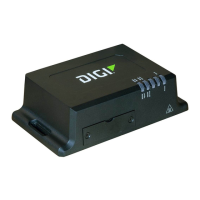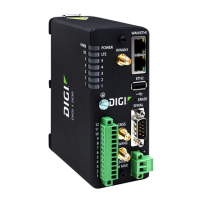Use the command-line interface Using the CLI parameter tables in this guide
Digi TransPort WR Routers User Guide 134
Using the CLI parameter tables in this guide
Many sections in this guide include tables showing the CLI parameters that relate to the web-based
settings. The CLI parameters nearly always take the following format; there are only a few
exceptions.
<entity> <instance> <parameter> <value>
Where:
<entity>=eth, ppp, modemcc, wifi, ike, eroute, etc.
<instance>=0, 1, 2, 3, etc… Some entities only use 0. Others have multiple instances.
<parameter>=The parameter name, such as, ipaddr, mask, gateway, etc.
<value>=The value to set, such as, off, on, 192.168.1.1, username, free_text, etc.
For example, the following table is displayed for Ethernet parameters:
To use this table, read the row from left to right and replace values as appropriate. The first four
columns only are needed for entering commands; the rightmost column shows the equivalent
setting in the web interface.
If the Instance is n in the table, it is because there are multiple instances available. Use the instance
number you need for your requirements. If the Instance is set to a specific number, such as 0, use
the number specified in the table.
For example, to set a Description of Local LAN on Ethernet 0, enter:
eth 0 descr “Local LAN”
Because of the space between Local and LAN, the wording is enclosed in double quotes.
To set an IP address on 192.168.1.1 on Ethernet 0:
eth 0 ipaddr 192.168.1.1
To set an IP address of 172.16.0.1 on Ethernet 1:
eth 1 ipaddr 172.16.0.1
To enable the DHCP client on Ethernet 2:
eth 2 dhcpcli on
Entity Instance Parameter Values Equivalent web parameters
eth n descr Free text field Description
eth n ipaddr Valid IP address IP Address
eth n mask Valid Subnet Mask Mask
eth n gateway IP address Gateway
eth n dnsserver IP address DNS Server
eth n secdns IP address Secondary DNS Server
eth n dhcpcli Off / On On=Get an IP address automatically using DHCP
Off=Use the following IP address

